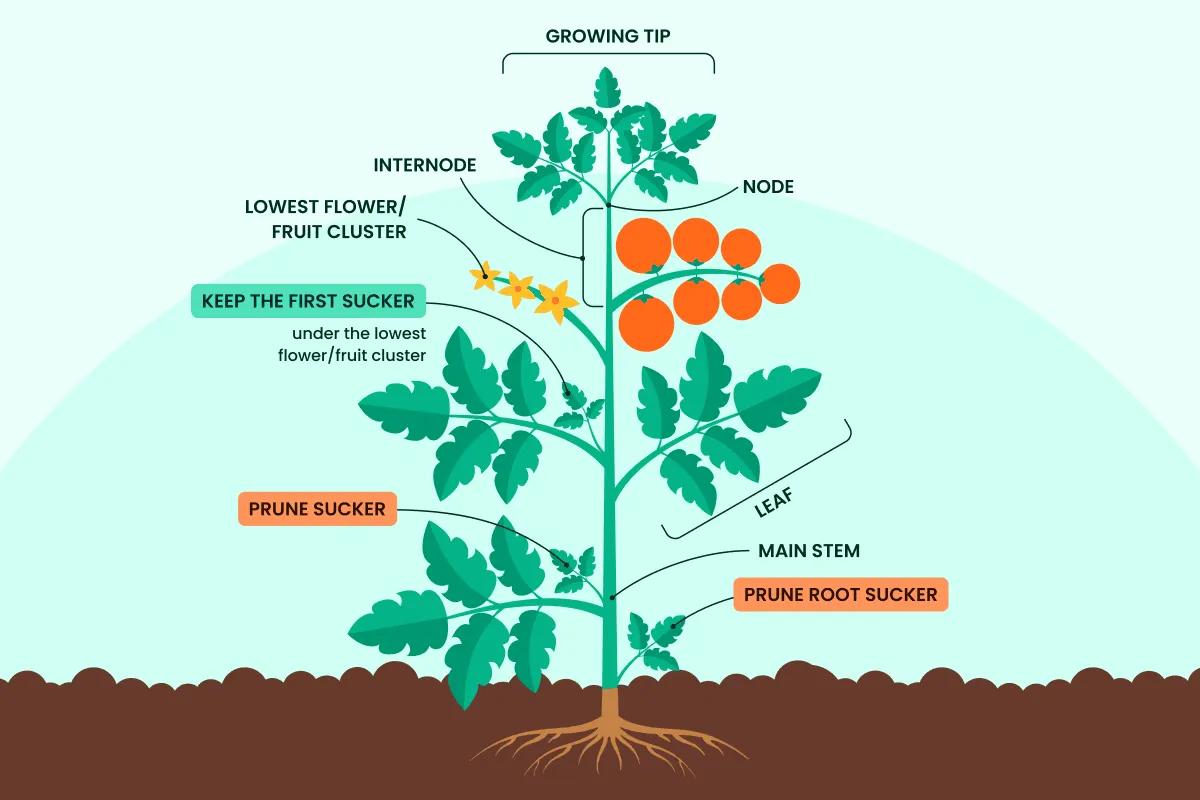When cultivating tomatoes, pruning plays a key role in maximizing the yield and quality of your fruit. Pruning helps direct nutrients toward fruit production, encouraging larger, healthier tomatoes. However, pruning techniques differ depending on the type of tomato plant you’re growing: indeterminate (vining) or determinate (bush-type).

Understanding Tomato Types
- Indeterminate Varieties: These plants, such as Big Boy, Beef Master, and most heirloom and cherry tomatoes, grow continuously and require pruning and support. Indeterminate tomatoes grow tall and produce fruit throughout the season.
- Determinate Varieties: Known as “bush” tomatoes (such as Biltmore, Patio, and Heinz), determinate plants grow to a fixed height, producing one concentrated crop before ending their life cycle. Minimal pruning is needed for these varieties, as they naturally focus energy on fruit production.
When to Prune
Pruning should start once your indeterminate plant reaches 12–18 inches in height and begins to flower. For determinate plants, pruning should be minimal to avoid hindering fruit production.
Pruning Steps for Indeterminate Tomato Plants
- Identify Suckers: Look for small shoots (suckers) where branches meet the main stem. These divert energy from fruiting and should be removed to encourage larger tomatoes.
- Remove Lower Leaves: Once the plant reaches about a foot in height, remove the leaves below the first flower cluster. This improves air circulation and reduces disease risk, especially in humid climates.
- Prune Small Suckers with Fingers: For suckers under 3 inches, use your fingers to pinch them off to avoid creating large wounds on the plant.
- Use Missouri Pruning for Larger Suckers: For thicker suckers (over the size of a pencil), pinch only the tips, leaving a few leaves behind to protect developing fruit from sunscald. This technique helps maintain plant health by reducing shock.
Pruning Technique Tips
- In warm, sunny zones, avoid removing leaves until they naturally turn yellow to keep soil shaded and moist.
- In humid environments, removing leaves below the first flower cluster enhances air flow, decreasing the risk of fungal infections.
- Always clean pruning tools or hands before pruning to prevent infections like Mosaic Virus.
Additional Tips for Supporting Indeterminate Plants
- Tie Plants to Supports: As indeterminate plants grow, they need support to prevent sprawling. Tie them gently to stakes or trellises to keep them upright and ensure proper nutrient flow to the fruit.
- Limit the Number of Fruit-Bearing Branches: Choose four or five sturdy branches to bear fruit, pinching out excess shoots. This strategy helps the plant focus on producing larger tomatoes rather than an overabundance of smaller fruit.
Final Season Pruning (“Topping”)
About a month before the first frost, trim the plant’s terminal shoot (the very top) to direct all energy to maturing fruit. This process, known as topping, is essential for ensuring that the final fruits of the season fully ripen.
Pruning for Determinate Varieties
Minimal pruning is recommended. Focus on removing dead or yellowed leaves, as excessive pruning can reduce the overall yield by removing fruit-bearing branches.
Troubleshooting: Common Pruning Questions
- When to Start Pruning: Begin when the first flowers appear on your plant.
- Brown or Dead Leaves: Remove any dead or diseased leaves to keep the plant healthy.
- Pruning Tools: Use sterilized tools or fingers for pruning, especially for larger shoots, to prevent disease spread.
Caring for Your Tomato Plants
By pruning correctly, you not only shape a stronger plant but also increase its ability to resist diseases, produce larger fruits, and utilize nutrients efficiently. With regular attention to pruning, your tomato plants will thrive, rewarding you with a bountiful and delicious harvest.
